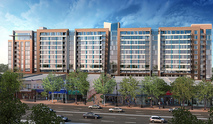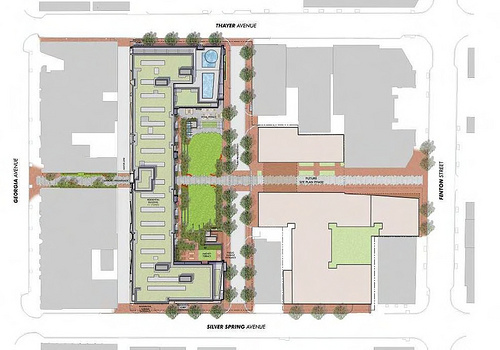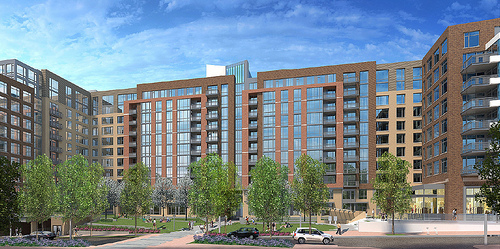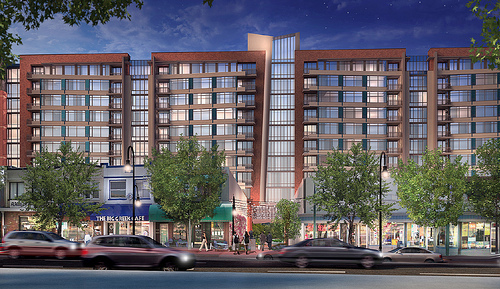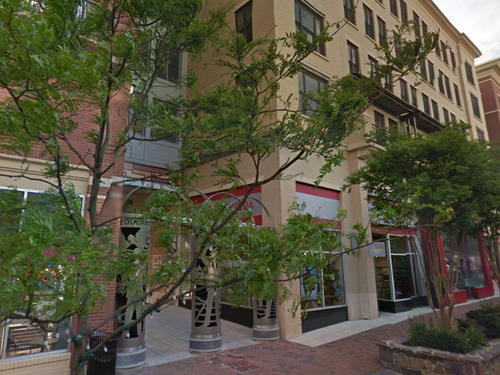Issue with Silver Spring apartment plan is design, not height
Neighbors in downtown Silver Spring say a proposed 11-story apartment building is too tall for the area. But as the project goes to the Montgomery County Planning Board, whose staff recommend approving the project, there are still problems with the proposal. It’s not the height, but the design of a single, long building instead of two.
In 2009, local developer Robert Hillerson proposed building a mixed-use complex with apartments, shops, offices and a hotel on most of a city block between Georgia, Thayer and Silver Spring Avenues and Fenton Street.
Community members supported that plan, but weren’t as excited about a new design Hillerson and national apartment developer Fairfield Residential Company presented last summer. As I wrote in October, what was originally a pair of buildings surrounding Mayor’s Promenade, a planned pedestrian passage between Georgia Avenue and Fenton Street, has morphed into one monolithic, block-long building with an underpass through it.
On Thursday, the developers will present a revised design (PDF) to the Montgomery County Planning Board, which is also holding a public hearing on the project. Neighbors, civic groups and even county councilmembers have written nearly 100 pages of letters to the board, mostly in opposition. They’re mainly worried about the project’s height and density, which one resident feels could turn Silver Spring into Crystal City.
While some good changes have been made since the summer, this project still isn’t ready to go. It’s not the height or density, both of which current zoning allows and which are in line with the rest of downtown Silver Spring. The real issue is with its design.
New design improves park, sort of improves building
As before, Studio Plaza will be broken up into two phases. The first phase, which is going before the Planning Board now, is for one 11-story building with 415 apartments, including 61 Moderately Priced Dwelling Units and 10 Workforce Housing Units for low-income households, and 10,000 square feet of street-level retail space. A second phase, to be approved later, will could add up to 340 apartments, 26,000 square feet of retail, and a 78,000 square foot office building.
There’s the aforementioned renovation and extension of Mayor’s Promenade and a new street, which help break down a big block and will improve pedestrian connections between Georgia Avenue and Fenton Street. At the intersection of the two is a 13,000-square-foot park, which will be privately owned but open to the public. The park will sit atop a parking garage meant to replace the existing parking lot.
Designed by Alexandria-based landscape architecture firm ParkerRodriguez, the park is one of the plan’s highlights. Before, it was just a bunch of blobs of lawn and pavement randomly thrown around. Now, there’s a simple, rectangular lawn divided in half by Mayor’s Promenade. It’s big enough for picnics and playing catch, with room for some planters in a geometric pattern that provides visual interest.
Facing the park is retail space, which has a terrace for outdoor dining, a shaded “amenity terrace” for tenants of the apartment building, and 8 ground-floor apartments with “real doors” and porches. Local artist Dan Steinhilber will make 23 public art pieces out of tubular steel, including lampposts, bike racks and benches, that will be placed throughout Mayor’s Promenade and the park.
The building, designed by WDG Architects of DC, is better as well. The old design used dark-colored brick and had narrow, relentlessly repetitive windows, which made the building feel large and heavy. That’s been replaced with a mix of warm-colored bricks and bands of glass broken up with attractive teal accents. It’s a more conservative design, but it helps the building feel less imposing.
Setbacks make the building now appear to be 9 floors tall on Thayer Avenue and 10 floors on Silver Spring Avenue. And on the new street, the building peels back ever so slightly at the intersection with Thayer Avenue, drawing visitors into the public park. Looking at the renderings of the building at night behind the low-rise storefronts on Georgia Avenue, I can start to imagine this building in real life.
Still a “very long building”
However, the biggest issue with the previous design remains: the first phase is still “a very tall, very long building,” in the words of county planners, that bridges over Mayor’s Promenade. Having a pedestrian passage that connects two streets and a park is probably the coolest part of the entire project, but this design choice turns it into an afterthought.
There are legitimate reasons for having one building instead of two, namely the ability to have one consolidated lobby, elevator core and service area for the entire complex. But as I’ve said before, breaking this building into two, or at least having a more delicate connection or bridge from one side to the other, would make the promenade a nicer space and assuage residents’ concerns about the building’s height and mass.
Fairfield and Hillerson should look to the apartment buildings at Rockville Town Square, which WDG also designed, for a better solution. They also bridge over pedestrian passages that connect the square to surrounding streets, but the bridges step back from the street so they’re not as deep as the rest of the building, which allows light and air into to the passage.
This project is as long if not longer than Studio Plaza, and it’s only 5 or 6 stories tall. Why doesn’t it make sense to do the same thing for an 11-story building?
Studio Plaza has its merits: it provides housing in an area where it’s in high demand, and is close enough to transit, jobs and shopping that residents won’t drive as much or at all. It’ll improve connections in downtown Silver Spring with two new streets and give people a new park for hanging out in.
However, the Planning Board still shouldn’t approve it. We can’t do much about its height, nor should we. But we can improve the way this building looks and relates to its surroundings. There have been a lot of less-than-great buildings in downtown Silver Spring, but this is a substantial project in a very prominent location. It deserves the best design possible.
Check out this slideshow of Studio Plaza, including the 2012 and 2009 plans.

